Fleets ‘need more trucks and trailers’ as supply chain clogs
Forecasting transportation equipment production in 2021 is like being the traffic reporter during rush hour: Everyone knows they’re stuck in a traffic jam, but it’s the reporter’s job to tell them anyway. That’s how Don Ake, FTR Transportation Intelligence vice president of commercial vehicles, prefaced his April 1 commercial vehicle market update.
“We're still going to look at the numbers, but we're stuck in traffic and I'm giving you the traffic report,” Ake said. “We're stuck in traffic because so many things are clogging the supply chain.”
For the Class 8 market, the semiconductor chip shortage is the leading source of the production slowdown; for trailers, it’s wood flooring. Problems, yes, but identifiable and predictably resolvable.
However, “it doesn’t stop there, but goes on and on,” Ake continued: tires, harnesses, stamped parts, steel, aluminum.
“It's all mixed together, and it's all bad,” Ake said. While the CV industry got out ahead of the traffic in the early stages of the recovery, now — with the broader economy rolling — multiple sectors are competing for many of the same materials.
For equipment manufacturers, the good news is pandemic recovery is excellent for freight and fleets; the bad news is OEMs can’t build equipment fast enough.
“Demand is ahead of supply, but in this case, supply is constricted,” Ake said. “It's not like we've hit capacity. It's like we can't get to capacity.”
For the truck OEMs, backlogs are not yet to 2018-19 levels, so there is still some room for order growth. Production, however, has slowed: After peaking at 24,000 units in October 2020, February Class 8 production came in at 19,000.
For trailer manufacturers, record orders in late 2020 have pushed the backlog to an all-time high. So the 2021 decline in trailer orders “doesn't say anything about the market; it just says that the cup is getting full, and there's less orders that we can take,” Ake added.
On the production side, trailer output “hit the wall” at 20,000 units and has been “pretty flat” due to supply constraints. Ake attributed a slight increase in February to recovering flatbed demand and “the supply chain issues on the flatbed market are not as severe — yet.”
2021-22 outlook
FTR expects GDP growth in the first quarter to arrive at an annual rate of nearly 10% — up from the 6.6% forecast previously for the quarter — compared to 5% growth in the fourth quarter of 2020. Growth diminishes for the rest of the year but is still strong at 4.8% in Q2, 4.2% in Q3 and 3.3% in Q4.
Even more impressive are the GDP Goods Transport figures from FTR, with “fantastic” growth in Q1 at 17.4%. That slips somewhat to 6% growth on Q2 — still robust, however.
“It's a very vibrant economy in the goods transport sector and it's pushing the freight and the freight rates,” Ake said.
FTR’s equipment forecasts are based on the research firm’s “economically derived demand” modeling, so the firm has a good idea of how many trucks and trailers should be built. However, Ake emphasized, the supply constraints are not accounted for.
“You can't collect data in a supply-based forecast — you can collect opinion, but you can't collect data,” Ake said. “On the demand side, demand is tremendous. Fleets need more trucks; they need trailers. Growth is strong.”
Chips are down
Anecdotally, FTR sources report that the chip shortage that has spread from the automotive side into commercial trucks could last until August. And, with Class 8 vehicles needing from 15 to 35 such chips, depending on the technology involved, “this is a big deal,” Ake explained.
“If you don't have chips, you have obvious production problems,” he said. “Typically, you have supply chain issues and then they get better. What's happened recently is that they've intensified.”
Indeed, while Volvo in late March announced scheduled “stop days” across its global truck manufacturing operations, “everybody is in the same situation,” Ake suggested.
“Nobody's significantly better or worse than anybody else,” he said. “There are reports many OEMs are partially assembling vehicles because they have to. And that's got to be a nightmare.”
And such a challenge for manufacturers, in turn, is a challenge for industry analysts: Partially assembled vehicles don’t count in the production totals until they’re delivered, which will result in some significant swings in the month-to-month totals for the next couple of quarters.
The trailer industry, likewise, has its own set of supply chain issues.
“Some trailer OEMs are saying this is such a mess, it could last to the fourth quarter,” Ake said.
2021 forecast and beyond
As a result, FTR has not changed its forecasts for 2021 but has pushed production into the second half of the year, with “rollover demand” impacting the 2022 outlook.
For Class 8, FTR’s 2021 production outlook remains at 298,000 units, with 2022 increasing from the previous projection of 319,600 to 325,000.
That market pressure is especially significant for trailer production, Ake suggested. FTR added 500 units to its 2021 outlook, bringing this year’s total to 283,500, and pushed 2022 production to 308,000 units, up from the previous forecast of 295,000 units.
Speaking briefly of the medium-duty segment, FTR’s Class 4-7 production total held at 225,000 units for 2021 and 238,500 for 2022.
The caveat to the FTR outlook, Ake noted, is that the possibility remains that OEMs will not be able to meet the revised forecast production levels in the second half of 2021, either. So further adjustments are likely.
Indeed, that rollover, combined with continued strong demand, could make 2022 the current cycle’s peak year, eclipsing the production totals FTR currently predicts for 2023.
“It's a tough market, it could get tougher — it presents a lot of challenges,” Ake concluded. “This is a tough time, but this is a tough industry. We will work as hard as we can, as long as we can, to make it work.”
About the Author
Kevin Jones
Editor
Kevin has served as editor-in-chief of Trailer/Body Builders magazine since 2017—just the third editor in the magazine’s 60 years. He is also editorial director for Endeavor Business Media’s Commercial Vehicle group, which includes FleetOwner, Bulk Transporter, Refrigerated Transporter, American Trucker, and Fleet Maintenance magazines and websites.
Working from Beaufort, S.C., Kevin has covered trucking and manufacturing for nearly 20 years. His writing and commentary about the trucking industry and, previously, business and government, has been recognized with numerous state, regional, and national journalism awards.




